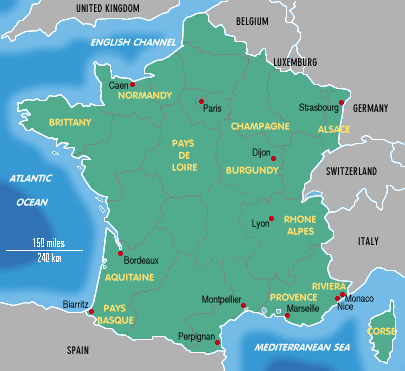 |
www.shejapan.com > World Heritages > Paris,Banks of the Seine
Quiz:
|
|
|
|
2. What country is aroud France?

Inscribed :1991 Criteria: C (ⅰ)(ⅱ)(ⅳ)
Brief description:
From the Louvre to the Eiffel Tower, from the Place de la Concorde to the Grand and Petit Palais, the evolution of Paris and its history can be seen from the River Seine. The Cathedral of Notre-Dame and the Sainte Chapelle are architectural masterpieces while Haussmann's wide squares and boulevards influenced late 19th- and 20th-century town planning the world over.
 The Romans who settled there in 52 BC named the place Lutetia. They got on well with the inhabitants and, in particular, the shipping people whose emblem was already a vessel whose shape somehow resembled both the island and a boat. It was their chief who represented the town and they who paid for the building of the public baths at Cluny.
Around 360, soon after Justin was proclaimed emperor in Lutetia, the town took the name of its inhabitants and became Paris. All that early history was very important in shaping the city's mentality, which is still much attached to natural elements. (1)The idea that a spate or an invasion can change everything is part of a Parisian philosophy which never takes anything for granted and is always eager to derive enjoyment from the here and now.
In fact, Roman euphoria was followed by the ordeals of invasions and epidemics, with the Vikings laying waste to the city on five separate occasions. At that point the Roman buildings on the left bank were torn down to surround the island with a thick stone wall behind which the entire population could take refuge.
It was not until the twelfth century, under Philippe Auguste, that prosperity returned. (2)It was from that period that the Paris we know today inherited its two chief treasures: Notre Dame cathedral, whose perfectly balanced form represents the archetypal Gothic cathedral, and the Sainte Chapelle, built by Saint Louis to serve as a tremendous showcase for the relics of Christ the Emperor of Byzantium had sold him. This building was a technical challenge from the outset, since nobody had ever built such a tall church with so little visible stone. It is interesting to note that the portion of the banks of the Seine inscribed in the World Heritage List (Notre Dame and the Pont Sully being a little upriver) is virtually bounded at either end by two technical challenges seeking to reconcile height, transparency and lightness; namely the Sainte Chapelle and the Eiffel Tower.
The Romans who settled there in 52 BC named the place Lutetia. They got on well with the inhabitants and, in particular, the shipping people whose emblem was already a vessel whose shape somehow resembled both the island and a boat. It was their chief who represented the town and they who paid for the building of the public baths at Cluny.
Around 360, soon after Justin was proclaimed emperor in Lutetia, the town took the name of its inhabitants and became Paris. All that early history was very important in shaping the city's mentality, which is still much attached to natural elements. (1)The idea that a spate or an invasion can change everything is part of a Parisian philosophy which never takes anything for granted and is always eager to derive enjoyment from the here and now.
In fact, Roman euphoria was followed by the ordeals of invasions and epidemics, with the Vikings laying waste to the city on five separate occasions. At that point the Roman buildings on the left bank were torn down to surround the island with a thick stone wall behind which the entire population could take refuge.
It was not until the twelfth century, under Philippe Auguste, that prosperity returned. (2)It was from that period that the Paris we know today inherited its two chief treasures: Notre Dame cathedral, whose perfectly balanced form represents the archetypal Gothic cathedral, and the Sainte Chapelle, built by Saint Louis to serve as a tremendous showcase for the relics of Christ the Emperor of Byzantium had sold him. This building was a technical challenge from the outset, since nobody had ever built such a tall church with so little visible stone. It is interesting to note that the portion of the banks of the Seine inscribed in the World Heritage List (Notre Dame and the Pont Sully being a little upriver) is virtually bounded at either end by two technical challenges seeking to reconcile height, transparency and lightness; namely the Sainte Chapelle and the Eiffel Tower.

(3)The history of the Seine does not stop here. We should not forget the great infatuation with the automobile marking the Pompidou years. The government was then convinced that the city would have to adjust to motor traffic and a project for a highway across Paris along the quays almost saw the light. The memory of this sacrilege reminds us just how sensitive our capital cities remain to any fatal idea. Fortunately, the banks of the Seine are now undergoing a large-scale improvement programme managed by Paris Town Hall. A continuous pedestrian way is being created and many celebrations are held on the river while a shuttle-boat enables travellers to move about in the summer. And so a quiet stroll along the Seine (whose banks Marie de Meceicis enjoyed so much that she had the first trees planted there), or an unhurried moment on the Pont Neuf (a meeting point of the fashionable crowd in 1578), will remain among life's pleasures in centuries to come.
Petit Palais
パリ支庁
he Cathedral of Notre-Dame
ノートルダム寺院
Cluny
クリュニー
Lutetia
フランスの首都パリの古代ローマ名
World Heritage
世界遺産
Parisian
パリの人
Gothic cathedral
ゴシック教会
epidemic
病気の流行
Emperor
皇帝
Unesco official site
Paris, wiki
sky business
Lonely Planet - Destination France: Lonely Planet Press' guide to Paris.
www.shejapan.com
> World
Heritages > Paris,Banks of the Seine
© 2005 SHEJapan.com